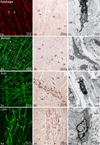Physiology, injury, and recovery of interstitial cells of Cajal: basic and clinical science
- PMID: 19778538
- PMCID: PMC2943431
- DOI: 10.1053/j.gastro.2009.09.023
Physiology, injury, and recovery of interstitial cells of Cajal: basic and clinical science
Abstract
In the last 15 years, our understanding of the cellular basis of gastrointestinal function has been altered irreversibly by the discovery that normal gastrointestinal motility requires interstitial cells of Cajal (ICC). Research in this relatively short time period has modified our original concept that the core unit that controls motility is made up of nerves and smooth muscle, to one that now includes ICC. This concept has now expanded to beyond the gastrointestinal tract, suggesting that it may be a fundamental property of the regulation of smooth muscle function that requires rhythmic contraction. ICC are distributed throughout the gastrointestinal tract, have important functions in the control of gastrointestinal motility and are often abnormal in diseased states. Recently, significant steps forward have been made in our understanding of the physiology of ICC as well as mechanisms of injury and recovery. These advances will be the focus of this review.
Conflict of interest statement
The authors disclose no conflicts.
Figures



References
-
- Huizinga JD, Zhu Y, Ye J, Molleman A. High-conductance chloride channels generate pacemaker currents in interstitial cells of Cajal. Gastroenterology. 2002;123:1627–1636. - PubMed
-
- d'Antonio C, Wang B, McKay C, Huizinga JD. Substance P activates a non-selective cation channel in murine pacemaker ICC. Neurogastroenterol Motil. 2009 - PubMed
-
- Gomez-Pinilla PJ, Gibbons SJ, Bardsley MR, Lorincz A, Pozo MJ, Pasricha PJ, Van de Rijn M, West RB, Sarr MG, Kendrick ML, Cima RR, Dozois EJ, Larson DW, Ordog T, Farrugia G. Ano1 is a selective marker of interstitial cells of Cajal in the human and mouse gastrointestinal tract. Am J Physiol Gastrointest Liver Physiol. 2009 - PMC - PubMed
-
- Strege PR, Ou Y, Sha L, Rich A, Gibbons SJ, Szurszewski JH, Sarr MG, Farrugia G. Sodium current in human intestinal interstitial cells of Cajal. Am J Physiol Gastrointest Liver Physiol. 2003;285:G1111–G1121. - PubMed
Publication types
MeSH terms
Grants and funding
LinkOut - more resources
Full Text Sources
Other Literature Sources

